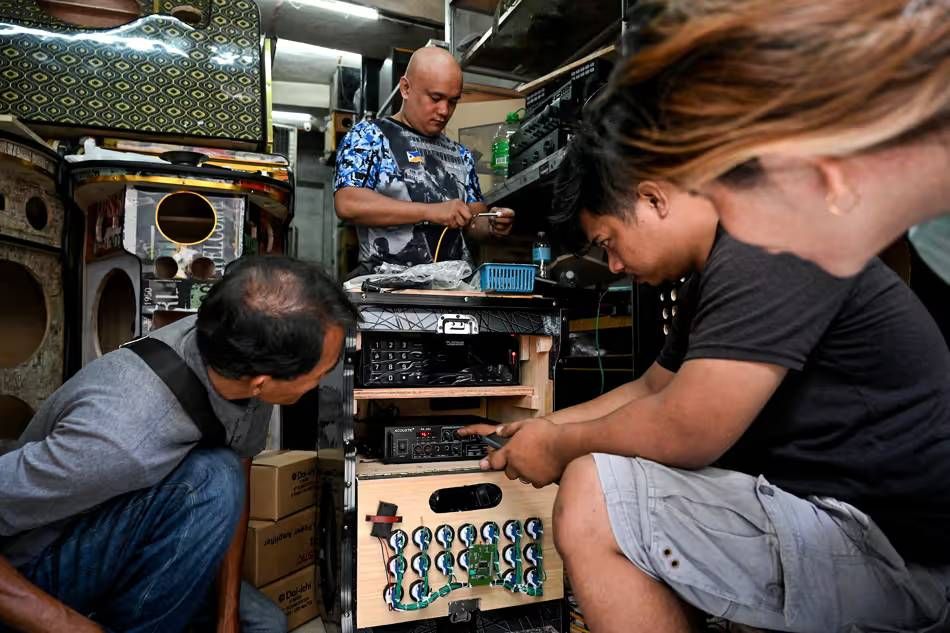Karaoke inventor Shigeichi Negishi dies at 100: WSJ | ABS-CBN
ADVERTISEMENT

Welcome, Kapamilya! We use cookies to improve your browsing experience. Continuing to use this site means you agree to our use of cookies. Tell me more!
Karaoke inventor Shigeichi Negishi dies at 100: WSJ
Karaoke inventor Shigeichi Negishi dies at 100: WSJ
Kyodo News
Published Mar 17, 2024 11:26 AM PHT
|
Updated Mar 20, 2024 01:28 PM PHT
 Customers look on as men assemble a karaoke machine at a shop in Quiapo, Manila on July 22, 2023. Jam Sta. Rosa, AFP/File
Customers look on as men assemble a karaoke machine at a shop in Quiapo, Manila on July 22, 2023. Jam Sta. Rosa, AFP/File
 Customers look on as men assemble a karaoke machine at a shop in Quiapo, Manila on July 22, 2023. Jam Sta. Rosa, AFP/File
Customers look on as men assemble a karaoke machine at a shop in Quiapo, Manila on July 22, 2023. Jam Sta. Rosa, AFP/File TOKYO — Shigeichi Negishi, known as one of the inventors of karaoke, died of natural causes on Jan. 26, the Wall Street Journal has reported his family as saying. He was 100.
TOKYO — Shigeichi Negishi, known as one of the inventors of karaoke, died of natural causes on Jan. 26, the Wall Street Journal has reported his family as saying. He was 100.
The WSJ said Negishi was the "first to automate and commercialize the singalong in 1967, although he never patented his creation."
The WSJ said Negishi was the "first to automate and commercialize the singalong in 1967, although he never patented his creation."
His "Sparko Box" first came to the market in 1967 and is "recognized as the earliest" karaoke machine by the All-Japan Karaoke Industrialist Association. He is also "the first among five Japanese inventors who independently created karaoke machines from 1967 to 1971," the WSJ said.
His "Sparko Box" first came to the market in 1967 and is "recognized as the earliest" karaoke machine by the All-Japan Karaoke Industrialist Association. He is also "the first among five Japanese inventors who independently created karaoke machines from 1967 to 1971," the WSJ said.
Another man is often more widely credited for inventing the karaoke machine. Daisuke Inoue, a Japanese musician, released the 8 Juke karaoke machine to the market in 1971.
Another man is often more widely credited for inventing the karaoke machine. Daisuke Inoue, a Japanese musician, released the 8 Juke karaoke machine to the market in 1971.
ADVERTISEMENT
But it was Negishi, the founder of a company that assembled consumer electronics such as transistor radios and who liked to sing along with television and radio shows, who in 1967 came up with the idea of wiring a microphone, speaker and tape deck together and playing an instrumental recording of a song, according to the WSJ.
But it was Negishi, the founder of a company that assembled consumer electronics such as transistor radios and who liked to sing along with television and radio shows, who in 1967 came up with the idea of wiring a microphone, speaker and tape deck together and playing an instrumental recording of a song, according to the WSJ.
Seeing the commercial potential of the device, Negishi eventually placed around 8,000 Sparko Boxes at various locations across Japan, including restaurants. The machine did not gain traction, however, and he exited the karaoke business in 1975, according to the WSJ.
Seeing the commercial potential of the device, Negishi eventually placed around 8,000 Sparko Boxes at various locations across Japan, including restaurants. The machine did not gain traction, however, and he exited the karaoke business in 1975, according to the WSJ.
Things changed after major manufacturers invested in the activity, and karaoke proliferated to turn into a form of leisure for people around the world, the report said.
Things changed after major manufacturers invested in the activity, and karaoke proliferated to turn into a form of leisure for people around the world, the report said.
ADVERTISEMENT
ADVERTISEMENT


